Q. Please introduce your family to our readers.
We are the Vawter family. In 2015 we sold or gave away everything we owned and moved aboard our 43ft sailboat. We have been living a location independent life ever since. The girls were 7 and 8 when we moved aboard and now, our eldest is about to enter high school! It’s been a pretty crazy ride. We had intended to do a 5 year circumnavigation, but we ended up taking a much more circuitous route and going much more slowly. In 2018 we sailed from Mexico to New Zealand and today we are finishing up a circumnavigation of New Zealand.Q. What do you enjoy about sailing – and touch upon the sailing lifestyle and freedom of being able to sail around the world?
Boaters often talk about all boats being a compromise, and that can extend to the life of a sailor as well. Great sacrifices must be made, but the rewards are deeply gratifying. The thing that we, as a family, most appreciate about our sailing life is the amount of time we are able to spend together. To heck with ‘quality time’ we have a quantity of time and it’s all of high quality.
When we were living on land, we were all pulled in so many directions. The girls were in school most of the day and when they were home it felt like a mad rush to do the activities, get homework done, get dinner in them, and get them to bed so we could do it all over again the next day.
While we have lots of time now, we are never bored. The boat requires continual maintenance. The constant need to plan our route while considering what we’d like to do, where we’d like to go and what is, or isn’t possible with the coming weather is ever present. The girls complete their homeschool and practice music daily.
There is a romanticism that gets attached to boats. One looks at them in the harbor and imagines sailing away and leaving it all behind – detaching from the world. It is a very tempting image. And it is true! But what comes along with this romantic image are hours of work in preparation, very serious responsibilities, and that very real, and difficult letting-go of things and people at home.
Q. What motivated you both to leave your jobs while with young children and sail around the world?
Before we were married we’d dreamed of doing something like this. Cameron had been inspired as a teenager by reading Dove by Robin Lee Graham and Maiden by Tanya Aebi. We didn’t want to wait until retirement like many people. There are no guarantees in life. That we would be healthy enough, let alone alive, is not a foregone conclusion. After my second child I was diagnosed with a rare form of cancer. Thankfully it was dealt with swiftly and I’m cancer free today, but that really made us take stock.
For the girls it certainly isn’t a typical upbringing. But we can’t imagine a better one. Every day is a bit like a field trip for them. They gut fish, change the oil, go for hikes, visit countless museums, drive the dinghy to go visit other kids on other boats, kayak, skin dive, collect and cook up shellfish and so so much more. The girls have serious responsibilities with real consequences to their actions. Their lives are free of some of the more insidious things in our culture. They don’t have phones and have never asked for one. They don’t worry about fashion trends. The complex social dramas inherent in school institutes just don’t seem to exist among the boat kid community. They are growing up close to us and close to nature.
Q. This question is for your children – what has been the most memorable part of this lifestyle?
(Adelaide, 13)
I think my favorite memory would be one I earned in a small uninhabited island in French Polynesia on the island of Raiatea. We and our boat friends were playing capture the flag with coconuts, and we kept slipping into the thick black ankle deep mud that bordered the coconut trees. The only audience to our raucous free-for-all was the cats. They had been put on the island by the Polynesians to keep the rat population at bay. We named their clan (of about seven cats total) the Cats Of The TangleWood Forest. I remember stalking through thick muddy underbrush feeding the Cats of The TangleWood Forest bits of coconut, and getting thoroughly soaked while trying to retrieve a coconut someone had thrown a little too aggressively.
(Elizabeth, 12)
One the most memorable times would be in Mexico, on one of the islands in the Sea of Cortez. We found a small farm with goats, dogs and mules. We got to go on a ride, mule-back, for four hours to a fresh water spring. It was fun. They gave us traditional handmade Mexican chaps and we were protected from the monster spines of the cactus we were brushing by.
Q. Describe your experiences sailing this year and has it altered your plans (if any).
The world is closed. Or, at least that’s how I feel sometimes. Yes, it has certainly changed our plans. If we had been able to stay on our planned course we would be somewhere in SouthEast Asia right now getting ready to cross the Indian Ocean toward South Africa. As it is, we decided to stay in New Zealand. There are still a small handful of countries open, but very few comparatively and the entry processes are a constantly changing web of bureaucratic hoops adding time, uncertainty, and expense.
We want to stay longer here in New Zealand, but we are running up against limits set by the government to VISA extensions. We were fortunate to be here when this whole thing went down! Some boats in other parts of the world were forced to leave the countries and their boats and repatriate. Others families were refused entry into countries after long passages as circumstances and border controls had changed between the time they departed and arrived. We know several families who were visiting home when the boarder controls started, and are now unable to rejoin their boats.
Q. Where did you experience the worst weather and how did you handle it?
This is by far the #1 question we get, but unfortunately we don’t have any really exciting answers to it. We are conservative sailors and we have the tools to take care of ourselves in heavier weather. If we ever feel like things are getting ‘sporty’ we reef down our sails, slow down the boat, change the sail plan, or hove-to if need be. If we can control our speed and direction then we are safe in almost any situation as long as land is not looming. It’s sometimes hard for non-sailors to understand but land is the most dangerous thing for an ocean going boat.
We also plan our passages during the ‘right season’ avoiding cyclone and hurricane seasons, taking advantage of typical wind and current patterns and never leaving port in a storm or on a schedule.
Our boat is really well made for what we are doing. She is a solid heavy displacement cruising boat with a full keel and rigged to deal with a wide range of conditions. We’ve been in the exact same conditions with other boats who were fully freaking out over the radio, while we felt very comfortable.
The most wind we’ve probably been out in is 45 knots which was off the coast of Fiordland in south western New Zealand and the biggest seas were probably 4-5 meter seas between islands in French Polynesia. Fortunately we’ve never been in anything super nasty with really steep, big, breaking waves. Sea state really is the main issue and we are fortunate that we haven’t been caught off guard.
Q. From my experience with sailing, it seems like things are always breaking. And how to manage this on a round the world trip?
“Cruising is just boat maintenance in exotic locations.” – a much quoted line. And, it is true. A mechanical inclination is really a prerequisite for safe cruising. We left port with so many spare parts. Some of them came with the boat and we didn’t even know what they were! Over the years we’ve discovered the purpose of most of them, discarded the broken ones and added innumerable tools and other parts. We have backups for our backups.
There are things you can do to minimize this though. We believe in simplicity of systems and this has kept our jobs doable. Because our boat is a slightly older vintage, she doesn’t have anything on her that Cameron can’t figure out with a good tool set, a fleet of spare parts, and the manual.
There is an amazing camaraderie in the sailing community as well. Many of the parts we carry on board we know are not meant for us, they are meant for another boat in a far flung port who will need it desperately. We have experienced the generosity of other boaters giving us parts, advice, and help when we’ve needed it. It’s just part of the culture. I think that you have to like this bit at least a little to really enjoy cruising.
Q. What was the scariest moment you had while sailing during so far during your trip (which started in 2015) and or where did you experience the worst weather and how did you handle it?
The scariest moment during our time on the boat was when we were crossing from the Tuamotus to Papeete in French Polynesia. We were somewhere out in the middle of the ocean sailing along nicely. All of the sudden we started to smell something, something that was burning.
Fire is a HUGE danger on boats. If you’ve ever watched a fiberglass boat burn, you know what I’m talking about. It will chill your soul.
Cameron sprung into action, shut off the electrical isolators, ran down and ripped up the floor boards to take a look at the engine (which had been running). Nothing. He ran around the boat, frantically opening cabinets and sniffing, looking for an electrical fire among the miles of electrical wires. Finally he found it – a kindle that was plugged in. It must have gotten a drop of salt water in the charging port and it was literally melting where the power entered the kindle. We yanked it off its cord and all took a very deep breath.
Our worst weather offshore was mentioned earlier. Our worst weather in port was just the other day sitting through 50 knot sustained winds with gusts to 60 and 70 here on Stewart Island, New Zealand’s third largest Island just south of the South Island. All of this happened when the forecast was for 40 knots. Our dinghy flipped with the engine attached while tied to the boat. This not uncommon in the far southern latitudes and we’re fortunate we were in a good anchorage.
Q. We need to respect the oceans – what lifestyle choices can we make and what can we do to protect our marine environments from ourselves?
A scary amount of the worlds garbage ends up in the ocean. You may think that because you put your garbage in the bin, that you aren’t contributing to this… but unfortunately, that’s not true. Much of our garbage goes to other countries and then gets inadvertently or purposely washed into the ocean. By purchasing products wrapped in garbage, we all contribute to the garbage problem. We were amazed how much garbage was on the beaches in remote atolls in the South Pacific. It was abundant and it wasn’t from the South Pacific. It had travelled from more developed nations upstream.
Take the 30 day challenge! Commit to buying zero single use plastic for one month. This will raise your awareness of how much forever garbage we all purchase and thus produce. We can make some simple choices that can change this in really big ways. Then, write to businesses and ask them to change their packaging to sustainable and biodegradable materials.
Consume a lot less, vote for climate protections and do whatever you can do to help people around the world to do the same.
Q. What do you miss most about the Napa Valley?
Friends. We made a lot of great friends in the valley and we miss that community the most.
—
All photographs above courtesy of Anne Vawter.

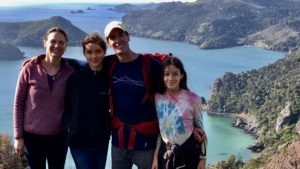
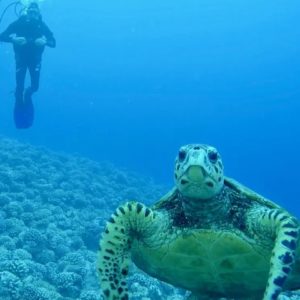
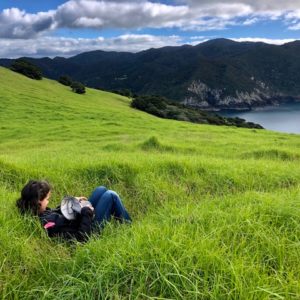
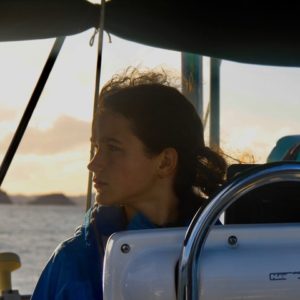

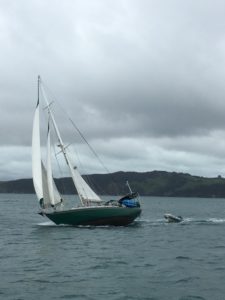

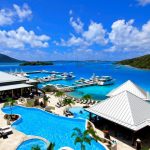




Nice interview with a closer look at the sailing life, what’s more, as a family!
Thanks Chin – reading this interview makes me want to get out on a boat again
Thanks for asking about how to respect the ocean. I think the challenge is a good idea.
I wonder what a normal daily diet is on the boat? Do you have anything fresh besides fish?
You are not the Vawters family. I am!!!
-Alayna Vawters
I think you both are